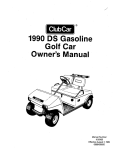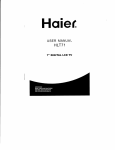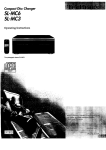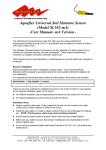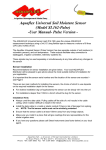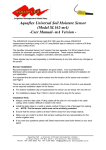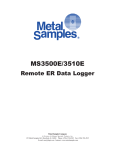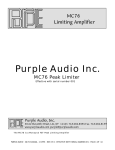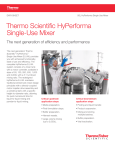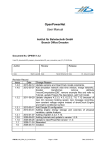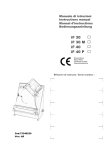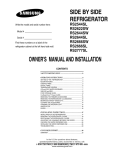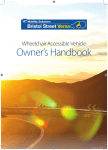Download Macro Carrier - Essential Healthcare Solutions
Transcript
ELECTRIC PROFILING COMMUNITY BED USER’S MANUAL This product conforms to the standards of the Medical Directive 93/42/EEC as implemented by Legislative Decree 46/97 and s.m.e.i. 1 1 5 2 7 3 4 6 1- HEAD PANEL 2- METAL 4-BAR BED RAILS 3- HANDCONTROL 4- BED RAIL RELEASE LEVER 5- FOOT PANEL 6- WHEELS WITH BRAKE 7- HOUSING FOR LIFTING POLE (ON BOTH SIDES) 2 INDEX 1. INTRODUCTION 2. GENERAL INFORMATION 2.1Groups of people mentioned in this manual 2.2 Safety warnings 2.2.1Safety symbols used 2.2.2 Safety warnings for the owner 2.2.3 Safety instructions for the user 2.3 Product description 2.3.1 Proper use 2.3.2 Special features 2.3.3 Materials used 2.3.4 Frame 3. ASSEMBLY AND OPERATIONS 3.1 Assembly 3.2 Operations 3.2.1 Requirements of the installation site 3.2.2 Operations 4. FUNCTIONING 4.1 Special safety warnings 4.2 Hand control 4.2.1 Hand control use 4.3 Swivel wheels 4.4 Lifting Pole 4.5 Bed rails 5. CLEANING AND DISINFECTING 5.1 General information 5.2 Clearing and disinfection program 5.3 Training of users 5.4 Detergents and disinfectants 5.4.1How to use disinfectants 6. MAINTENANCE 6.1 By the user 6.2 By the owner 6.3 Spare parts 6.4 Manufacturer’s address 6.5 Electrical components replacement 7. ELIMINATING DEFECTS 8. TECHNICAL DATA 8.1 Size and weight 8.2 Electrical data 8.3 Environmental conditions 8.4 Norms and applied guide lines 9. WARRANTY 10. DECLARATION OF COMFORMITY 3 Pg.4 Pg.5 Pg.5 Pg.6 Pg.6 Pg.6 Pg.7 Pg.8 Pg.8 Pg.8 Pg.8 Pg.9 Pg.10 Pg.10 - 11 Pg.12 Pg.12 Pg.13 Pg.13 Pg.13 Pg.14 Pg.14 Pg.15 Pg.15 Pg.16 Pg.17 Pg.17 Pg.17 Pg.18 Pg.18 Pg.19 Pg.19 Pg.20 Pg.21 - 24 Pg.24 Pg.25 Pg.25 Pg.26 Pg.27 Pg.27 Pg.27 Pg.27 Pg.28 Pg.28 Pg.29 1. INTRODUCTION Dear customer, Apollo Healthcare Technologieswishes to thank you for purchasing one of our nursing bedsand for the trust shown in our products. The electrical safety and functionality of each bed have been tested by the manufacturer in order to avoid any faults. This manual provides useful information to the buyer and to the end user on all the functions which will allowa safe and practical daily use of this bed. Therefore we recommend you to use this manual as a handy guide and to keep it near your bed. In the hope that for you and for the users of this nursing bed to succeed, we are confident that our product will greatly contribute to achieving this goal. 4 2.GENERAL INFORMATION Before using the bed: Read through this whole manual in order to avoid causing damagesto the bed due toimproper use. Before using the nursing bed, the user must verify its perfect status and complete efficiency. This bed conforms toall the requirements of Directive 93/42/EEC for medical products and it is classified as a Class I medical device. This manual contains safety instructions which must be fully respected. All the people involved withusingthe bed must know the complete contents of this manual and observe the safety warningslisted herein. Information for the owner: Every electrical appliance may cause hazards if used incorrectly. Therefore it is necessary to instruct the user on how to use the nursing bed correctly. Inform the user of where this manual will be kept. 2.1 Groups of people mentioned in this manual The manual may refer to the following groups of people somehow involved with using the bed: Owner The owner (for example: suppliers of medical products, dealers, health care authorities, etc.) can be any physical person or juridical body which uses the nursingbedor under whose name the bed is being used. The owner is responsible for providing the necessary information to the user. User the user is the person authorized to use the nursing bedand to carry out any operations on the bed on the basis of his/her training, experience or education, and who has been trained to use the bed. Furthermore, the user must be able to recognize and avoid potential hazards and evaluate the condition of the patient. • Patient In this manual the term patient refers to the person who needs to be taken care of, who might be sick or disabled and therefore in need of using this bed. Specialized personnel The term specialized personnelrefers to the owner’s co-operators who are authorized, on the basis of their training or education, to deliver and assemble. 5 2.2 Safety warnings The nursingbed is a high technology product, therefore make sure to read the complete manual when delivered. Make sure to use the nursing bedonly if it is in good condition. The goal of the safety warnings is to avoid injuries to people. 2.2.1 Safety symbols used The following symbols appear in this manual: Warnings against injuries This symbol indicates the presence of dangerous power voltage which could jeopardize the user’s life. This symbol indicates the presence of hazards which might jeopardize the user’s life and cause health problems. Warnings against damages toproperty This symbol indicates a potential damage to things or properties. Damages to the bed mechanism, to its materials or to the environment might occur. Other warnings This symbol indicates a general useful suggestion. Following this suggestion, it will be easier to use the bed and to understand the instructions. The safety symbol used does not replace the safety text it refers to. It is always necessary to read the relevant safety warning in full and to follow it carefully! 2.2.2 Safety warnings for the owner Before the bed is used, inform the user about safelyoperating the bed by strictly following this manual which must be provided together with the bed.Inform each user of any possible dangers due to any improper use. Pay special attention when using the electric functions and the bed rails. Nursing beds are classified as active Class I medical devices. You must fulfilyour obligations in accordance with the current regulations about installation, operation and use of medical devices, to ensure a safe and durable use of this medical product without any risks for patients, users and any third parties. In case of a prolonged use of the bed,it is necessary to carry out an inspection, after a certain period of time (we recommend at least every year), to check its functionality and any visible damages (see Chapter 6). 6 Make sure that only qualified personnel use this bed. Make sure that any possible substitute personnel are also sufficiently trained on how to use the bed correctly. In case any additional electricaccessories are used such as air compressors for overlay mattresses, make sure they are properly installed and work correctly. In particularpay attention to the following: Make sure all cables, flexible tubes etcare fixed correctly. Do not use a multiple socket under the bed (possible fire hazard in case of contact with liquids). If in doubt, please contact the manufacturer of the accessories. Make sure all staff complies with the safety warnings. 2.2.3 Safety instructions for the user Make sure to be instructed on the safe use of the bed bythe owner. Before each use check the good condition and the absence of defects in the nursing bed. Make sure there are no obstructions such as furniture or inclinations of the ceilingwhen making any adjustments. In case any additional electric components are also used such as hoists, reading lamps or air compressors for overlay mattresses, make sure their cable does not get caught in the mobile parts of the bed or get damaged. Multiple sockets must not be used for connecting any external electrical components. If you suspect damage or malfunctioning, immediately disconnect the power plug from the wall, clearly mark it as “Damaged” and deactivate the nursing bed. Immediately inform the owner of the bed about this situation. In chapter 6.1 you will find a checklist to assess the condition of the bed. Safety warnings for the user The power cord must be installed so that when operating the bed it is not carried away, crushed or damaged by any moving parts. Before transport totally remove the plug from the socket. When the bed is not used, make sure there is no possibility for the hand control to fall and get damaged (it must remain attached to the hook). Make sure the cable cannot be damaged by any moving parts of the nursing bed. Place the bed in thelowest position when you leave the patient unattended on the bed. In so doing, the risk of injuries to the patient when getting on and off the bed is minimized. The adjustments can be made only by trained personnel or in the presence of experienced staff. Check the power cord regularlyfor possible mechanical damages (abrasions, uncovered wires, bends, dents, etc…) especially in the following cases: after each mechanical overload (for example: crushing of the cable with the bed itself or with atrolley, after strong tractions and bending of the bed with the power cord plugged in) after each change of position/after every movement before inserting the plug during the normal operation by the user Regularly check that the power cord assembly is properly tightened. 7 2.3 Product description 2.3.1 Proper use The nursing bed, hereinafter simply called “bed”, is designed for disabled or ill people and is suitable also for home care. The bed was not specifically designed for hospital use. This bed can be used for treatment with a doctor’s prescription and it can be used for diagnosis, care or observation of the patient. This bed does not have any special options suitable for an equipotential connection. Make sure to take this aspect into accountbefore connecting with any other (medical) equipment already linked to the power supply. This bedmust be used only by adequatelytrainedpeople. This bed is designed for repeated re-use. Please follow the instructions listed below: Cleaning and disinfecting (see chapter 5) Maintenance / Verification of tests (see chapter 6.2) This bed can be used only according to the use conditions described in this manual. Any other use is not to be considered as proper. 2.3.2 Features Electric height adjustment of the bed surface from 22 to 67 cm. Electricbackrest (with Auto-Regression) section adjustment from 0° to 72°. Electric leg section adjustment from 0° to 33°. Four swivel wheels, individually lockable. Hospital surface 198x 88 cm. Integrally extendable to 213x88cm. Overall dimensions about 210 x 106. Bed rails on both sides drop down level with mattress platform. 2.3.3 Materials used The bed ismostly made up by steel tubing profiles, covered by a polyester powder coating or by a metallic zinc or chrome coating. The head/foot panelsare made of wood or similar material, whose surface is waterproof. The surfaces are not harmful in contact with the skin. 8 2.3.4 Frame The bed is supplied disassembled to beeasily transported into the house. It is made up oftwo metal frames with wooden panel inserts (head panel and foot panel), a mattress base with amotor, apantograph mechanism with an electric actuator, two four-bar metalbed rails and one lifting pole with grab bar (accessory NOT included with the bed).The bed has four swivel wheels, all with a parking brake. Mattress base The mattress base is divided into a backrest with auto-regression, a fixed central element, a leg support and a knee raiser with ratchet. These elements are adjustable. The foot or head parts of the mattress base can be adjustedin height horizontally or obliquely compared to the floor. All the adjustments are performed by electric motors by using a hand control. The mattress base can be extended by 15cm simply by moving the foot panel outwards and the integral mattress support. Bed Rails To protect patients from possible accidental falls from the bed, the bed is equipped with rails (meet clause 201.9.8.3.3.3 of IEC 60601-2-52)on both sides, which can act as a barrier or be lowered when not in use. The blocking mechanism is locked and it can be released only by pulling the lever outon the side (see No. 4 on Page 2) Electric system The electric operating system of this bed is safe and easy to use. It consists of: Electronic controller. A minimum protection voltage of 24 volts is produced which is not dangerous for the patient and the user. The electric motors and the hand control are connected to the central controller with connectors, which work with a minimum protection voltage of 24 volts. Separate electric motors for the back and the leg supports. Two electric motorsto adjust the height of the mattress base (one in each bed end). A hand controlunit with fixed hook. 9 3. ASSEMBLY AND OPERATIONS The bedis supplied disassembled. The bed is assembled on location by the retailer’s personnel. The installation must be carried out by a minimum of one person. Packaging units: Carton 1: Mattress platform, side rail end caps, mattress retainers. Main control unit, hand control, back & foot rest actuators and connecting cables in a box inside Carton 1; Carton 2: Bed ends (head and foot panels) each with a Hi-Lo actuator; Carton 3:Two metal 4-bar bed side rails. 3.1 Assembly Mounting instructions: The assembly of the bed must be carried out by a minimum of one person ; Unscrew the 4 hand screws on both the head and foot halves of the frame. Use the bars provided to connect the two halves of the frame together,ensuring the end of each bar with the blue dot is inserted first into the fame with the blue dots. Also note the location tab should be facing down as shown in the photo above. Once the two halves of the frame are fully pushed together,hand tighten the hand screws. Swing the headboard / footboard connecting bars outwards 90 degrees to align with the main bed frame. The footboard is provided with longer connecting bars in order to enable the bed to be extended. 10 All the actuators on the bed are colour coded. The back rest actuator has red stickers that should be matched up with the corresponding red stickers on the mounting points on the underside of the bed frame. Equally, the green stickers on the foot rest actuator should be matched up with the green stickers on the mounting points. The main control box comes already attached to the back rest actuator with all the cables colour coded. Ensure the correct connector is attached to the matching actuator. The Hi-Lo actuators on the head and foot boards should be connected using the yellow stickered connectors. Pay attention to position the back and foot rest actuators correctly! They should never be inverted. Make sure not to damage any cables. Verify that the cables do not get tangled and that they do not get caught in any in moving parts. In case of replacement of any individual components, always make sure that the electric plugs are then properly inserted into the controller. Only in this way the bed will function properly. 11 3.2 Operations Every time before using the bed, the user must make sure that: the wheels of the bedare locked (see also chapter 4.3). the power supply is compatible with the bed (230 Volt, 50 Hertz). the power cable is plugged in and placed in such a way that it cannot be damaged. the power cable, the motor cables and the hand control cable are not damaged by any moving parts of the nursing bed. there are no obstacles in the way such as bedsides or chairs. all control functions have been accurately inspected (see also chapter 6.1) and are working properly. only after having carried out the above operations it will be possible to start using the bed. 3.2.1 Requirements of the installation site Make sure there is enough space to allow the whole range of adjustments of the bed. There should not be any furniture or other objects close to the bed such as window cills. If the bed is to be used on parquet floor, make sure that the use of wheels will not cause any discolouring due tothe parquet waterproof treatment. It is possible to use the bed on tiles, carpets, laminated floors and linoleum. A 230 volt power outlet, correctly installed, must belocated asnearas possibleto the bed. If there is the need to use other accessories (such as compressor systems etc…), make sure they are correctly fixed and that they work properly. In particular, make sure all different cables are safely connected. In case of questions or doubts please contact the manufacturer of such accessories. During the installation of the bed you must take the following issuesinto serious consideration to minimize potential fire hazards due to external influences. Inform the user and the personnel about these issues! If possible, use only non-flammable mattresses and linens. Don’t smoke while in bed as there is no guaranteeagainst risks caused by smoking tools(such as lighters, matches) depending on the mattresses and linens used. Use any electric accessories (electric blanket) and appliances (lights, radios) only if they are in a good condition. Make sure these appliances are used only for their intended purpose and that they cannot accidentally end up on and under the sheets (risk of overheating). Absolutely avoid using extension cables or connections to multiple sockets under the bed (fire hazard due to the penetration of liquids). Extension cables and/or power multiple socketsshould never be used at all. 12 3.2.2 Operations After the assembly of the bed, make sure to carry out an inspection in conformity with chapter 6.2. . After carrying out all the instructions listed in chapters 3.1 3.2.2 the bed can start functioning. 4. FUNCTIONING 4.1 Special safety warnings When making the adjustments make sure that no parts of the body of any patients, users and other people, especially children, arepositioned under any adjustable elements or under the bed frame to avoid being caught and injured. Once you have made the necessary adjustments and positioned the bed rails correctly, make sure to lock the backrest and leg adjustments possibilities with the hand control, to protect the patient from unwanted movements (risk of crushing of his/her limbs). In case of use of accessories onthe electric bed, make sure such accessories do not crushor cutthe patient with sharp edges during the legs and backrest adjustments. If this condition is not guaranteed, the user must not proceed with the backrest and legs adjustments. Make sure the power cable and the hand control cable do not get caught anywhere or get damaged. Before each operation with the bed, make sure the power cable is not stretched, crushed or damaged in any way. When making the adjustments, make sure there are no obstructions such as furniture or a ceilinginclination, to avoid possibledamages. As with all electrical appliances, despite the compliance with prescribed values, it is not possible to totally exclude the possibility of interferences from other electrical devices which might be nearby (for ex. the “buzz” of a radio). Insuch a rare case, increase the distance of the bed from the interfering device, do not use the same socket or temporarily disconnect such device. 13 4.2 Hand control The electric functions of the bed are activated by the patient and by the user with a hand control. The electric motors work if the corresponding buttons are pressed. It is possible to adjust different sections in both directions. The hand control can be attached to the bed where needed with a hook. The spiral cable allows freedom of movement. 4.2.1 Hand control use Backrest adjustment Press this button to change the angle of the backrest. Height adjustment of the mattress base Press this button to change the height of the mattress base. When the height is adjusted there is an automatic horizontal positioning of the mattress base in the highest and/or lower position. Leg support adjustment Press this button to change the angle of the leg support. Backrest and leg support combined adjustment (Auto-Contour) Press this button to change the angle of the backrest and the angle of the leg support simultaneously. Angle adjustment of feet – head section (Trendelenburg Tilt) Press this button to lower the foot or head section independently. When the height is adjusted there is an automatic horizontal adjustment of the mattress base if lowered at the feet in the highest position and/or in the lowest one. Before lowering the section you need to release the brake of the two wheels on the head or foot panel side, to avoid possible damages to the floor. 14 4.3 Swivel wheels The nursing bed has four swivelling castors which can be blocked individually. Bring the mattress base into its lowest position. Before each operation of the bed, make sure the power cable is not stretched, crushed or damaged in any way. How to insert thebrake:Press the lower lever down with your foot until the upper lever snaps up. How to unlock the brake:Press the upper lever with your foot until the lower lever clicks. Upper lever Lower lever 4.4 Lifting Pole In both corners of the mattress base, towards the head panel, there is a roundinsert with a cavity into which the lifting pole must be placed. The lifting pole must be insertedin the side from where the patient gets in or out of the bed to help him/her out. Assembly Place the lifting pole into its housing. The metal pin must be placed into the cavity. Make sure to double check the oscillationfield of the lifting polewhich must be limited. Disassembly Remove the lifting pole from its housing by pulling it upwards. Height adjustment of the handle The height of the lifting polehandle can be adjusted with the strap supplied. 15 4.5 Bed rails Fitting The bed rails are handed (Left & Right). Before fitting take note to ensure that the rail will collapse towards the foot of the bed. Secure the bed rails to each side of the bed frame by fully unscrewing the hand screws and fitting the brackets over the frame. Fully tighten the hand screws when the rails are located correctly. The top of the bracket must be flush with the top of the bed frame with no movement possible up or along the frame. Lowering and Raising To lower the rail pull out the black lever fully and collapse the rail towards the foot of the bed, ensuring that no body parts or wires/pipes are going to get entrapped in doing so. To raise the rail, simple lift the rail upwards and towards the head of the bed until the black lever clicks back into the locking hole. Special safety rules for the bed rails. The bed rails are there to protectpatients from possible accidental falls from the bed. However, they cannot prevent the patient from voluntarily leaving the bed. To make the best use of their intended protection function, please observe the following precautions: Use only undamaged bed rails and in good conditionspositioned at the right distance to allow the rails to snap into place properly. Make sure to use only the Apollooriginal bed rails supplied with the bed. Whenusing a bed with bed rails you must always verify if they are suitable for each individual patient. In particular, it is necessary to pay attention to the distance between the bars in relation to the patients’body build. If they are very skinny and thinit could be necessary to use some padding or pads around the bed rails (optional). Only in this waywill it be safe to use the bed without the risk ofthe patient to becaughtor to slide out of the bed rails. The mechanical elements which attachthe bed and the rails should be checked regularly to make sure there are no signs of damage. This must be done not only before applying the bed rails, but also during use within short intervals (at least before any new use). When applying the bed rails to the electric bed always make sure to block the backrest and leg supports with the hand control to protect the patient from any accidental electric movements (risk of involuntarily crushing the patient’s limbs). Failure to comply with the above safety ruleswill lead to the possible risks of the patient getting caught in the bed rails, falling out of the bed if the bed rails are too wide due to possible damages, in case they are not the correct bed rails for the electric bed or if they have not been mounted and inserted correctly. 16 5. CLEANING AND DISINFECTING 5.1 General information Clearing is fundamental as well as a proper chemical disinfection. In general, regular cleaning of the bed when used by a single patient is sufficient in terms of hygiene. It is necessary to disinfect the bed frame only in case of a visible contamination with contagious or potentially contagious materials (ex. blood, urine, pus etc.) or in case of a contagious disease upon request by the physician. Every time the bed is used by a new patient, it is mandatory to first cleanand then disinfect the bed by scrubbing thoroughly! Before you start clearing: Remove the plug from the socket and make sure it does not come into contact with water or disinfectant. Make sure all plugs are properly connected. None of the electric components must be externally damagedto avoid the penetration of water or disinfectant liquids which might lead to malfunctioning or damages to the electric components. Before using the bed again, by drying or blowing in the power plug, make sure there is no residual moisture left in the electrical contacts. The electriccomponents must not be subjected to a water jet, a high pressure cleaner or anything similar! Cleaning should be done with a damp cloth! If you suspect that water or moisture haveentered into the electriccomponents, immediately remove the power plug from the socket outlet and do not plug it in again. Mark clearly the bed witha “Faulty” sign and make sure it cannot be used. Inform immediately the owner of the bed aboutthe problem. In case of non-compliance with these safetyrules, it is not possible to exclude the risk of serious damages to the bed with related consequences! 5.2 Cleaning and disinfection program Remove the sheets from the bed to be washed. Clean all surfaces including the mattress platform, the plastic inserts and cables with a mild non aggressive detergent, including the hand control. The bed should be disinfected by scrubbing using a disinfectant recommended for hospital use especially in case of visible contamination with contagious or potentially infectious material. The same as applicable to beds in intensive care or infectious diseasesunits. It is necessary to disinfect the wheels only in case of visible contamination with infectious or potentially infectiousmaterial. Note: A continuous disinfection is necessary only in case of patients with multi-resistant pathogens within a hospital 17 5.3 Training of users and specialized personnel To ensure aproper cleaning and disinfecting procedure, we recommend you to appropriately train all users andspecialized personnel involved. The following points must be respected: Make sure thebed does not get soiled or contaminated during transport to the patient’s house. In case of disassembly of the bed, it is necessary to immediately clean and disinfect it by scrubbing. The personnel must be informed about the correct cleaning and disinfecting procedure and carry out his/hernecessary treatment properly (according to the steps of the procedure notified by the owner). The disinfectant used must be suitable for the treated surface. For this operation the specialized personnel shall be provided with waterproof disposable gloves and aprons. For the treatment only clean cloths should be used which must then be taken to be washed. After the treatment the personnel should disinfect their hands before leaving the place to go somewhere else. The qualified personnel must be equipped with a disinfectant with dispenser. Cleaning of the bed directly on site has the advantage that the bed and/or none of its parts can get "soiled" when thentransported in the same vehicle with other clean beds. It prevents potentially infectious germs located in the bed frame from spreading around. These recommendations will help to prevent nosocomial infections.If the beds are not immediately reused, they should be stored away with a cover to protectfrom dust and accidental contamination. 5.4 Detergents and disinfectants Make sure to follow the recommendations listed below to maintain the bed functionality as long as possible: All surfaces must be intact and any damages must be immediately eliminated. We recommend using a method of disinfection (wet) by scrubbing. The detergent should not be aggressive (not harmful for the skin and for surfaces) and it must be ecological. In general you can use a household detergent. To clean and disinfect the painted metal partsuse a damp cloth with a common non aggressive mild household detergent. The disinfectant for scrubbing the bed must be chosen from among those recommended (in the indicated concentration). Despite the mechanical strengthof the bed it is necessary to remove any scratches and dents in the paint with special repair kits in order to prevent moisture penetration. Never use abrasive clearing products and stainless steel cleaners containing solvents or clearing pads, to avoid damaging the bed surface. Note – Aldehyde-based disinfectants normally covera wide action rangeand are ecological. However, they are potentially allergenic and irritating. Glucoprotamina preparations do not present this problem and are very effective even though in most casesthey are quite expensive. Disinfectants based on chlorine splitting compounds can 18 have a corrosive effect on metals, plastics, rubber or other materials in case of a prolonged contact or in high concentrations. In addition, these products can be irritating for mucous membranes and do not have a great environmental resistance. 5.4.1 How to use disinfectants Pay attention to the proper dosage! We recommend using automatic dispensers. Prepare the solution always with cold water to prevent the buildup of vapours which might be irritating for mucous membranes. Wear gloves to avoid any direct contact with the skin. Do not store the disinfectant solutions in open bottles or containers. Make sure to always close them! Use bottles with pump dispensers to wet the cleaning cloth. Ventilate the room after the disinfection. Carry out the disinfection by scrubbing and not by spraying the disinfectant in a large quantitativewith the risk of being inhaled. This is why rubbing plays an important role. Do not use alcohol for large surfaces. 6. MAINTENANCE Regulations The owners of the nursing beds,in accordance with the applicable regulations in force, are requested to guarantee the safety conditionsof the medical products during their use. To achieve this, it is therefore necessary to regularly carry out inspections and maintenance interventions. Notes for the owner This bed was manufactured to function properly for a long period of time. When usedcorrectly, it can be operated for around 2 to 8 years depending on the conditions and frequency of its use. After repeated operations of transport, assembly, disassembly, improper and long-term use it is not possible to exclude that any damages, faults, wear and tear problems might occur. These problems may cause safety risks if not recognized and solved in time! Therefore it is necessary both for the owner and the user to follow the safety norms for medical devices with the implementation of regular inspections to verify the correct functioning of the bed. Inform the user that it is mandatory to carry out these controls. 19 6.1 By the user In addition to regular checks by the specializedstaff, even the normal users (such as nurses, assistants, etc.) must perform both a visual and a functional inspection before each new use at regular intervals. Recommendation: check all mechanical and electrical components once a month. In addition check the power cord and the hand controlcable after each mechanical stress and after each change of position. See the checklist below. Checklist for the user Control ok Visual inspection of electrical components Hand control cable Possible damages, cable connection Power cord Possible damages,cableconnection Hand control Possible damages Visual inspection of mechanical components Lifting pole and its housings Possible damages, deformations Bed frame Possible damages,deformations Metal mattress platform Possible damages,chips Wooden head and foot panels Possible damages, wooden chips Mattress base Possible damages, deformations Metal bed rail bars Possible damages, chips Functional control of electrical components Hand control Test to check if it works properly Functional control of mechanical components Casters Test the brakes, moving forwards Emergency descent of the backrest Test according to the instructions Bed rails Locking and unlocking mechanisms Knee raiser Mechanism and attachment 20 not ok Problem description Accessories Fixing, possible damages Inspector’s signature: Control result: Date: If you think that there might be damage or a functional problem, the bed mustnot be used at all and it must be disconnected fromthe power supply until the damaged components have been totally replaced or repaired! To replace or repair damaged parts, please contact the owner of the bed. 6.2 By the owner The owner of this nursing bed is required to carry out regular tests in case of any new installation, any maintenance service and during the normal use operations to ensure the safety of this bed. These tests must be verified during the regular maintenance services depending on use conditions. The functional tests, the evaluations, the documentation of the inspection results must be carried out only by experienced personnel who know the proper way and conditionsnecessary to implement a correct testing. The evaluation and the documentation of the results can be performed only by skilled electricians with additional medical and technical knowledge. The controls must be carried out according to the sequence below: 1. Visual inspections 2. Electrical measurements 3. Functional tests Frequency of the inspections As a benchmark, we recommend an examination every six months can be extended in accordance with the terms of use on its own responsibility respecting a share of proven error of 2% to a maximum of two years. If you think that there might be a damage or a functional problem, the bed mustnot be used at all and it must be immediately disconnected from the power supply until the damaged components have been totally replaced or repaired! 21 The pages below can be used as aninspection protocol. Sheet 1 of 2 Client/ Medical Centre/Surgery: Address: Task carried out: Testing of the bed Testing before the first use of the bed ing after repair / maintenance Device type: Nursing Bed Protection class: Bed type: Inventory number: Place: Serial number: Manufacturer: Apollo Healthcare Technologies Ltd. Parts used:none Equipment used (Type/ number of inventory): 1. Classification according MPG:class I 2. I. Visual inspection ok Visual inspection of electrical components Identification labels and stickers In place and clearly readable Housing of the control device Properly positioned, damages Housing and lifting tubes of the motors Properly positioned, damages Hand control Damages Power cable of the motors, hand control cable Properly positioned, damages Connector and clamp of the controller Properly positioned Visual inspection of mechanical components Identification labels and stickers In place and clearly readable Lifting Pole Damages, deformations Bed frame Damages, deformations Metal mattress platform Damages, chips Wheels Damages Mattress base Damages, deformations Wooden panels Damages, wooden chips Welding Welding problems Bed rail bars Damages, chips 22 not ok Problem description Knobs Worn out parts, such as the hinged points Correct fixing Damages II. Electrical measurement in accordance with VDE 0751-1:2001-10 (powerfrom the device, direct ) Proceed as follows: ok not ok Problem description 1. Insert the power cord of the bed into the testing outlet of the measuring device. 2. 2. Connect the probe of the measuring device to a free conductor element of the frame (such as a screw or similar). 3.Activate the motors with the hand control for the duration of the measurements 4. Start the measurement procedure with the appropriate device. Value of the first measure ment ma Limit Value Result: bed SK II (type B) 0,1 ma Current actual value ma Protocol system for testing electrical medical devices Sheet 2 to 2 III. Functional control ok not ok Problem description Functional control of electrical components End stroke of the motors Automatic disconnection Controller and motors Unusual noises Controller and motors Test according to use instructions Strain relief cord Connecting cable properly fixed Functional control of the mechanical components Hinged and pivot points Working smoothly casters Brakes, moving forwards Bed rails Locking and unlocking mechanisms Knee raiser Hinge point Accessories (ex. Trapeze bar, handle) Mounting, damages, suitability Inspection result: All values within the allowed range: yes no Next inspection date: 23 The test was passed: If the test was not passed: Mark test applied: This inspection protocol included: Notes: Tested on: Examiner: Signature: Evaluated on: Owner/staff: Signature: 6.3 Spare parts Replacement parts are available From Apollo Healthcare Technologies Ltd. by indicating the item number, order number and serial number. The necessary information can be obtained from the identification label placed on the bed. Model Bed model Type Article number Series Serial number 24 6.4 Manufacturer’s address To obtain a proper functioning and warranty replacements it is necessary to use only original spare partsApollo Healthcare Technologies Ltd! To order spare parts, for any requests or assistance and for further information please contact: Essential Healthcare Solutions UK Ltd Essential Enterprise Village Fieldhead Lane Birstall West Yorkshire WF17 9BN Tel: 0845 344 1912 Fax: 0845 344 1913 Email: [email protected] 6.5 Electrical components replacement Dangerous for your life, life threat, due to electric shock! Before starting any operations remove the plug from the wall outlet! Any electrical equipment operations must be carried out only by qualified service and repairstaff members, by the producer or by qualified and licensed electricians, in accordance with VDE and relevant safety standards! Disassemble the operating system only in the horizontal position to avoid the danger of being crushed by any elements falling from the mattress base.The drive components are maintenance free and can not be opened. In case of malfunction, the component in question must be completely replaced! 25 7. ELIMINATING DEFECTS Should any anomalies occur during use, it is necessary to contact the owner’s qualified personnel trained for the maintenance and repair of the bed. The user shall in no case try to eliminate any malfunctions that might occur in the electrical equipment! Dangerous for your life, life threat,due to electric shock! Any interventions to the electrical equipment must be carried out only by qualified service and repair staff members, by the producer or by qualified and licensed electricians, in accordance with VDE and relevant safety standards! Possible solutions The following table is useful to eliminate possible problems and faults: Problem The hand control and / or theoperating system does not work Pressing the keys, the movements are activated only for a short time Movement in one direction only Function in contrast with the instruction on the hand control The movements stop immediately after a longer adjustment time Possible causes Solution Power cord not connected Plug not under voltage Hand control plug not properly connected Faulty parts Insert the power cord Check the socket / the fuse box Check all connections Inform the owner and ask for repairs Reduce the load Remove the obstacle Inform the owner and ask for repairs Too much weight on the bed The bed hits against an obstacle Defective hand control or operating console Reversed motor connectors Activation of the circuit breaker in the transformer 26 Inform the Manufacture and ask for repairs Put in a rest position and let the system cool down for about 20 to 30 minutes 8. TECHNICAL DATA 8.1 Size and weight Bed fitted with rails: Apollo – Pandora Mattress base 88 x 198 cm (216cm) Overall dimensions 106 x 210 cm Weight capacity 200 kg 8.2 Electrical data Operating device (Main Control Unit): Type Ti-MotionTC1 Series Control Unit Input voltage AC 230 V, ± 10 %, 50 Hz Classification Class I Hand control: Type Ti-Motion Electric motors for height adjustment of the mattress base and backrest and footrest: Type Ti-Motion TA7 Series Linear Actuators Max speed at no load / full load (mm/s) 38 / 23.2 8.3 Environmental conditions Noise during adjustments: max. 48 dB(A) The following environmental conditionsmust be respected: Storage: Storage temperature: Relative humidity: Minimum Maximum + 5° C + 50° C 50 % 70 % Functioning: Environmental temperature : Relative humidity: Air pressure: Minimum Maximum + 10° C + 40° C 20 % 90 % (without condensation) 700 hPa 1060 hPa 27 8.4 Norms and applied guide lines Directive CE 93/ 42 VDE 0751-1:2001-10 Medical Devices Directive Safety verification for electrical devices Technical aids for disabled persons Appropriate design for disabled persons Application of risk management to medical devices Adjustable beds for disabled persons Safety of electrical medical equipment Electromagnetic compatibility Nursing beds electrically controlled (if required for home care) Classification as class I medical product (according to MPG § 13) EN 12182:1999-11 DIN 32977-1:1992-07 EN 14971: 2001 DIN EN 1970 : 2005-10 EN 60601-1: 1996-03 EN 60601-1-2:2002-10 DIN EN 60601-2-38/A1: 2001 9. WARRANTY Thebeds have a 2 year warrantyperiodfor any production faultsfrom their purchase date. Keep the purchase receipt. In particular, the guarantee of the beds will NOT cover: Damages due to improper use by the user; Damaged or ruined parts due to wear and tear or due to excessive exposure to sunlight; Damages caused by loss or spillage of liquids; Damages from collisions or impactsagainst walls, furniture etc.; Tears and accidental damages, cigarette or open flames burns etc. WarrantyTerms The warranty is not transferable; Repairs must be carried out by an authorized dealer. Any repairs or alterations made by someone other than the dealer will void the warranty; The warranty of any replaced components will have the same expiry date of the original warranty; The warranty will be void in the followingcases: Damages caused by lack of maintenance; Damages caused by incorrect maintenance; Modifications or repairs carried out by someone other than the dealer; Modifications or repairs with parts not original. If the device has problems, please contact your local authorized dealer and give all the information necessary to identify the defect and the type of repair. The manufacturer reserves the right to change weights, measures or other technical data contained in this manual without notice. The information contained in this manual is approximate. 28 10. DECLARATION OF CONFORMITY The Company Essential Healthcare Solutions UK Ltd Essential Enterprise Village Fieldhead Lane Birstall West Yorkshire WF17 9BN Declares that The articles which it sells, called ……………and related accessories, are classified as Class I non-invasive Medical Devices according to Medical Directive 93/42/EEC and to national law no. 46/97 and comply with the European Directive on CE marking; in addition they are not measuring instruments; they are not intended for clinical investigations; they are sold in non-sterile packaging; The above mentioned devices meet with the essential requirements and provisions of Directive 93/42/EEC. Essential Healthcare Solutions UK Ltd Essential Enterprise Village Fieldhead Lane Birstall West Yorkshire WF17 9BN Tel: 0845 344 1912 Fax: 0845 344 1913 Email: [email protected] 29





























